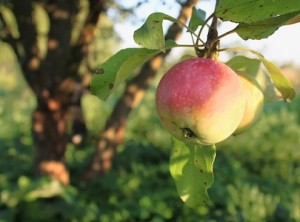In planning your homestead garden, you may not have considered growing fruit. To the inexperienced, it may seem like a challenging task, but growing fruit trees is not as difficult as you may think. And the return on your efforts will be vast. From a single tree, you can expect to get hundreds of fruits each year for up to twenty years. Depending upon the number and types of trees that you plant in your home orchard, you can have fresh fruit up to eight months out of the year.
By growing your own fruit, you will save money after the initial investment. You will be producing your own organic fruit, which at market is quite pricey. In fact, you may even be able to make money. You are likely to produce more fruit than your family can eat. Selling or trading the surplus is a great option. Your orchard will also be good for the environment. The trees will attract natural wildlife and pollinators like bees and bats. And you will take yourself and your family out of the cycle of growing fruits with harmful pesticides and shipping them by truck throughout the country.
 Selecting Your Trees
Selecting Your Trees
When you picture an orchard or fruit trees, you are probably imagining a large-scale, commercial property with large trees that require ladders for pruning and harvesting. As a small farmer or even just a backyard gardener, you don’t need to go with such large trees, which are called standard. You can use dwarf or semi-dwarf trees, which are smaller and easier to manage. Even if you don’t have much property, you can still fit in several dwarf trees by putting them close together and pruning them to keep them small.
The ideal amount of space for a dwarf fruit tree is eight feet in diameter. They are not difficult to prune because they never grow very tall, and they produce normal-sized fruit (although fewer than larger trees). Semi-dwarf trees like to have fifteen feet and grow from ten to sixteen feet tall. They must be pruned once a year and will produce hundreds of fruit at each harvest. A standard fruit tree is twenty-five to thirty feet tall. They take several years to reach full size and begin to produce fruit after three to five years.
Choose your trees based on your needs and how much effort you will be able to put into pruning, harvesting, and processing your fruit. Your orchard job will be much easier if you choose varieties that are natural to your local environment. Exotics are fun, but they are difficult if they do not grow well where you live. Consider your soil too. Pears and apples can tolerate dry soil, but drainage is important. Peaches develop blight when there is too much rain, so they do well when in a protected area. Plums prefer damp soil. Speak with someone at your local nursery to find out which fruits will work best in your area.
New Natural Fertilizer Doubles Garden Production…
Once you have chosen the size and type of trees that you want for your yard, select individual trees. There are several things to look for when picking the best individuals. Look for a straight and strong stem. Trees that are leaning or crooked can present problems later on unless staked and corrected. There should be a defined “leader” branch, which is a central branch that grows straight up from the trunk. Without a strong leader, you will find it more difficult to prune a shape into your tree. The rest of the branches should be growing evenly to either side of the leader. Avoid trees with low branches, which can attract pests later and get in the way of lawn care. Your new tree should have plenty of roots.
Planting Your Trees
With your trees picked out from the nursery, it’s time to get them into the ground. For most fruit trees, good drainage is important. Test your soil by digging a hole where you hope to put a tree. Dig about a foot down and pour water into the hole. If the water has not drained within three hours, the spot is not good for a fruit tree.
To plant your trees, dig a hole that is about eighteen inches deep, depending on the size of the tree. Loosen the soil on the sides and bottom of the hole and add water. Let the water drain out and then line the bottom with good compost. Put some soil back in the hole to make a small mound. Put the root ball on top of the mound and make sure the graft line on the tree is a few inches above the level of the ground. The graft line is a slight bulge near the base of the trunk where a bud was grafted to the rootstock to create your tree. Fill in the hole and compress the soil lightly. Mound it up around the tree by an inch or two. Make sure that the tree is vertical. Add mulch around the trunk. Always keep the graft line exposed.
Once your tree is in the ground, you may need to stake it, especially if the tree is on sloping ground. Stake it firmly in place, making sure you leave enough space for the trunk to grow. If you have deer that visit your property, you may need fencing around your tree. Deer love the bark of young trees.
Pollination
Without pollination, your trees will make no fruit. Even if you see plenty of flowers in the spring, there is no guarantee that you will see fruits in the fall. When you purchase your fruit trees, find out how they are pollinated. Some are self-pollinating, while others require assistance. Knowing what your trees need from your local environment is important. To improve your chances of getting the trees pollinated, there are several things you can do:
- Attract bees, the natural pollinator. Planting flowers throughout your garden will attract bees. You can also provide homes for bees near your fruit trees. Houses for mason bees are easy to make and can be purchased as well.
- Avoid insecticides. Don’t kill your newfound pollinators. Insecticides are very detrimental to natural pollinators and should be avoided as much as possible.
- Plant two varieties of the same tree. This can increase the odds of successful cross-pollinating. Even self-pollinators can benefit from this practice.
- Try multi-graft trees. Some nurseries produce grafts that include a few compatible varieties on one tree. The different varieties pollinate each other, ensuring a good harvest.
Pruning
It can be easy to ignore the need to prune. It is not always an easy task, especially if you have large trees. But if you prune your fruit trees annually, you will be rewarded with more fruit and more years of production. The best time for pruning is just before growth begins in the spring. When you are pruning, the goal is to create the best shape for your tree, to allow light to penetrate to all the leaves, and to remove dead or diseased branches. It can be difficult for the beginner to know how to go about this correctly. If you are new to fruit trees, discuss pruning with an experience grower or someone from your local nursery.
Tips for a Great Harvest
If you treat your trees well, you will get plenty of fruit throughout the year. Ensuring a good harvest begins with selecting the right trees, planting them in the appropriate locations, adequate pollination, and annual pruning. Additionally, there are some tips that can make your trees even more productive:
- Keep the graft line exposed. When the graft line dips below the surface of the ground, you may be surprised with a different type of fruit than you expected. When a graft is created, a different type of fruit is often placed on a hardy rootstock. When that graft line is below ground, the tree may revert to the type of fruit from which the roots came. You may think you are getting peaches and end up with crab apples instead.
- For peaches and apples, thin out some of the earliest, small fruits to ensure that the tree has the energy to produce larger fruits later.
- When transporting your new tree, keep the roots damp and covered to avoid shock.
- Deal with pests. One very common pest is the apple maggot. They are flies that burrow into the fruits to lay eggs. These then hatch into maggots. To kill the flies, you can hang red sphere traps, which are sticky.
- Water during dry seasons. If your area suffers from a dry spell, water your fruit trees thoroughly every two weeks.
- Rake up the leaves from your fruit trees. It can be detrimental to allow the leaves to build up on the ground.
©2012 Off the Grid News
 Off The Grid News Better Ideas For Off The Grid Living
Off The Grid News Better Ideas For Off The Grid Living




